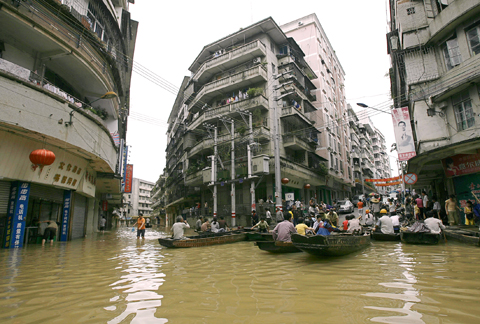China has posted hundreds of police and rescue officials to shore up dams threatening to burst under torrential rain that has already flooded 23,300km² of crops and homes.
The rain and floods, concentrated in the industrial hub of Guangdong Province, have killed at least 171 people and left 52 missing since the start of the annual flood season and forecasters have warned of more downpours in coming days.
More than 750 government officials and police had been sent to conduct rescue work for six reservoirs “in danger of bursting” in the Guangxi region, Xinhua news agency said.

PHOTO: AP
Some 3,000 people had already been evacuated downstream from a reservoir with a capacity of 1.8 million cubic meters, the agency said.
More than 1.66 million people have been evacuated across nine provinces and regions in southern China since major flooding started 11 days ago.
Families were perched on the roofs of homes flooded up to the first-floor ceiling, enduring the latest in a series of disasters in Beijing’s Olympic year after record snowstorms in January and February and the devastating May 12 earthquake.
Rain-triggered floods have toppled 134,000 houses, damaged or destroyed 2.32 million hectares of crops and caused economic losses of 27.7 billion yuan (US$4 billion).
China’s meteorological bureau forecast storms in western Guangdong and southern Guangxi and warned authorities to halt outdoor work and guard against damaged electric cables.
Water levels in the swollen Xijiang and Beijiang rivers in Guangdong were subsiding slowly, but rain forecast over the next three days would provide renewed risk of flooding, Xinhua said.
Heavy rains forecast for neighboring Fujian Province could also “cause geological disasters.”
Provincial water authorities earlier reported that the Pearl River Delta, a major exporting base, had suffered its greatest flooding in 50 years.
Analysts have warned sustained rains could reduce sugar production in Guangxi, which accounts for 60 percent of the country’s crop.
Rain has also been forecast for quake-hit areas of Sichuan, where officials have warned of renewed threats of epidemics as summer temperatures rise.
BIRTH OF ‘LOVE’
Meanwhile, a pregnant woman who was pulled from rubble in Sichuan 50 hours after she was trapped, gave birth to a healthy, pink-cheeked 3.3kg girl at the Urumqi Maternal Care Hospital in her home region of Xinjiang.
Zhang Xiaoyan’s dramatic rescue was a rare bright spot after the May 12 quake.
The image of rescue workers pulling the eight-month pregnant victim onto a stretcher two days after the quake, her stomach protruding from under a blue sweater and pink pants, was played on TV screens and newspapers across the country.
“Even if I didn’t make it, I just wanted my baby to survive. I was holding out hope during the earthquake that this day would come,” Zhang, 35, said yesterday as she reclined in a hospital bed with her daughter swaddled in a pink floral blanket beside her.
She named the baby Ai (“love”) in honor of the rescue workers and strangers who showered her with kindness, gifts and VIP treatment in the month since she was pulled out of the debris.
Zhang’s husband, Pan Yuncheng, a native of Sichuan, remains in Dujiangyan where he is living in a refugee camp.

POLITICAL PRISONERS VS DEPORTEES: Venezuela’s prosecutor’s office slammed the call by El Salvador’s leader, accusing him of crimes against humanity Salvadoran President Nayib Bukele on Sunday proposed carrying out a prisoner swap with Venezuela, suggesting he would exchange Venezuelan deportees from the US his government has kept imprisoned for what he called “political prisoners” in Venezuela. In a post on X, directed at Venezuelan President Nicolas Maduro, Bukele listed off a number of family members of high-level opposition figures in Venezuela, journalists and activists detained during the South American government’s electoral crackdown last year. “The only reason they are imprisoned is for having opposed you and your electoral fraud,” he wrote to Maduro. “However, I want to propose a humanitarian agreement that

ECONOMIC WORRIES: The ruling PAP faces voters amid concerns that the city-state faces the possibility of a recession and job losses amid Washington’s tariffs Singapore yesterday finalized contestants for its general election on Saturday next week, with the ruling People’s Action Party (PAP) fielding 32 new candidates in the biggest refresh of the party that has ruled the city-state since independence in 1965. The move follows a pledge by Singaporean Prime Minister Lawrence Wong (黃循財), who took office last year and assumed the PAP leadership, to “bring in new blood, new ideas and new energy” to steer the country of 6 million people. His latest shake-up beats that of predecessors Lee Hsien Loong (李顯龍) and Goh Chok Tong (吳作棟), who replaced 24 and 11 politicians respectively

Young women standing idly around a park in Tokyo’s west suggest that a giant statue of Godzilla is not the only attraction for a record number of foreign tourists. Their faces lit by the cold glow of their phones, the women lining Okubo Park are evidence that sex tourism has developed as a dark flipside to the bustling Kabukicho nightlife district. Increasing numbers of foreign men are flocking to the area after seeing videos on social media. One of the women said that the area near Kabukicho, where Godzilla rumbles and belches smoke atop a cinema, has become a “real

‘WATER WARFARE’: A Pakistani official called India’s suspension of a 65-year-old treaty on the sharing of waters from the Indus River ‘a cowardly, illegal move’ Pakistan yesterday canceled visas for Indian nationals, closed its airspace for all Indian-owned or operated airlines, and suspended all trade with India, including to and from any third country. The retaliatory measures follow India’s decision to suspend visas for Pakistani nationals in the aftermath of a deadly attack by shooters in Kashmir that killed 26 people, mostly tourists. The rare attack on civilians shocked and outraged India and prompted calls for action against their country’s archenemy, Pakistan. New Delhi did not publicly produce evidence connecting the attack to its neighbor, but said it had “cross-border” links to Pakistan. Pakistan denied any connection to